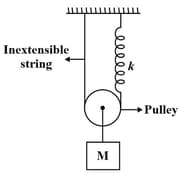Linear SHM
Linear SHM: Overview
This topic covers concepts such as Spring-Block System, Angular Frequency with Real Spring, Reduced Mass in SHM, Horizontal Oscillations of a Spring Mass System, and Vertical Oscillations of a Spring Mass System.
Important Questions on Linear SHM
A horizontal cylinder closed at one end contains an ideal gas which is compressed by a tight-fitting and frictionless piston. The piston is connected to the other closed end of the cylinder via a spring with spring constant . The piston is of cross-sectional area and mass . In equilibrium, the chamber containing the gas has pressure and length while the spring is compressed by . Let the the piston be displaced by towards the vacuum region, and released. Choose the correct statement(s) regarding the oscillations of the piston by assuming all processes are isothermal.
If is the displacement of a particle performing SHM, then is equal to its _________ energy.
The K.E of a particle performing simple harmonic motion is _______ whose displacement is .
The kinetic energy and potential energy of a particle exerting simple harmonic motion of amplitude will be equal when displacement is
For a body executing SHM, its potential energy for displacements and are and respectively. Then what is the potential energy at a displacement .
Plot the graph of potential energy versus time for a pendulum performing the simple harmonic motion.
Graph of kinetic energy in terms of displacement in SHM :-
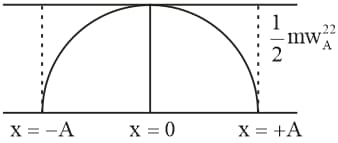
At displacement _____ of a particle executing SHM, has maximum kinetic energy.
A mass is suspended one by one by two springs of force constants . The time periods of their oscillations are respectively. If the same mass be suspended by connecting the two springs in parallel then the time period of oscillations is .The correct relation is:
A solid block on a frictionless surface is connected to two rigid supports on the left and right side by springs of spring constants and respectively as shown in the figure. The time spent by the block in a complete cycle of oscillation on the left and the right side of the equilibrium position are and respectively. Which of the following is correct?

If a watch with a wound spring is taken on to the moon. It
The time period for small vertical oscillations of a block of mass when the masses of the pulleys are negligible and spring constant and is
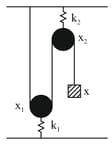
An arrangement of spring, strings, pulley and masses is shown in the figure below.
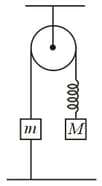
The pulley and the strings are massless and . The spring is light with spring constant . If the string connecting to the ground is detached, then immediately after detachment
A force constant of ideal spring is . It is loaded with a mass at the lower end the period of its vibration is:
Two blocks of masses and are moving with speed and in the same direction on the frictionless surface respectively, being ahead of . An ideal spring of force constant is attached to the backside of (as shown). The maximum compression of the spring when the blocks collide is

A mass is suspended from a weightless spring and it has time-period . The spring is now divided into four equal parts and the same mass is suspended from one of these parts. The now time period will be:-
Angular frequency in SHM is given by . Maximum acceleration in SHM is and maximum value of friction between two bodies in contact is , where N is the normal reaction between the bodies.
Now the value of k, the force constant is increased, then the maximum amplitude calculated in above question will
Electrostatic force on a charged particle is given by . If q is positive and if q negative
In the figure mA = mB = 1 kg. Block A is neutral while qB = - 1C. Sizes of A and B are negligible. B is released from rest at a distance 1.8 m from A. Initially spring is neither compressed nor elongated.

Equilibrium position of the combined mass is at
A body of mass is attached between two massless springs of force constant on a smooth plane of inclination . The other ends of the springs are fixed to vertical walls. The time period of oscillation of the body will be
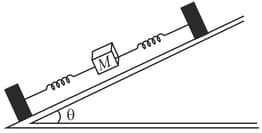
Statement 1: Acceleration must be proportional to displacement and directed towards mean position in a simple harmonic motion.
Statement 2: A mass is suspended from vertical spring of some force constant and the equation of motion is as shown in the Figure, then it shows that motion is not simple harmonic unless is negligibly small.
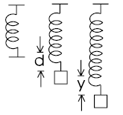
The time period of mass when displaced from its equilibrium position and then released for the system as shown in figure is

